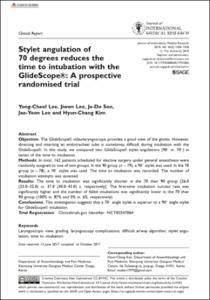KUMEL Repository
1. Journal Papers (연구논문)
1. School of Medicine (의과대학)
Dept. of Anesthesiology & Pain Medicine (마취통증의학)
Stylet angulation of 70 degrees reduces the time to intubation with the GlideScope (R): A prospective randomised trial
- Keimyung Author(s)
- Lee, Ji Won; Kim, Hyun Chang; Son, Je Do; Lee, Yong Cheol
- Journal Title
- Journal of International Medical Research
- Issued Date
- 2018
- Volume
- 46
- Issue
- 4
- Keyword
- Laryngoscopic view; difficult airway algorithm; grading; laryngoscopy complications; stylet angulation; time to intubation
- Abstract
- Objective The GlideScope® videolaryngoscope provides a good view of the glottis. However, directing and inserting an endotracheal tube is sometimes difficult during intubation with the GlideScope®. In this study, we compared two GlideScope® stylet angulations (90° vs. 70°) in terms of the time to intubation. Methods In total, 162 patients scheduled for elective surgery under general anaesthesia were randomly assigned to one of two groups. In the 90 group ( n = 79), a 90° stylet was used. In the 70 group ( n = 78), a 70° stylet was used. The time to intubation was recorded. The number of intubation attempts was assessed. Results The time to intubation was significantly shorter in the 70 than 90 group [26.0 (23.0-32.0) vs. 37.0 (30.0-43.0) s, respectively]. The first-time intubation success rate was significantly higher and the number of failed intubations was significantly lower in the 70 than 90 group (100% vs. 87% and 0% vs. 6%, respectively). Conclusions This investigation suggests that a 70° angle stylet is superior to a 90° angle stylet for GlideScope® intubation.
- Publisher
- School of Medicine (의과대학)
- Citation
- Yong-Cheol Lee et al. (2018). Stylet angulation of 70 degrees reduces the time to intubation with the GlideScope (R): A prospective randomised trial. Journal of International Medical Research, 46(4), 1428–1438. doi: 10.1177/0300060517741065
- Type
- Article
- ISSN
- 0300-0605
- Appears in Collections:
- 1. School of Medicine (의과대학) > Dept. of Anesthesiology & Pain Medicine (마취통증의학)
- 파일 목록
-
-
Download
 oak-2018-1052.pdf
기타 데이터 / 396.43 kB / Adobe PDF
oak-2018-1052.pdf
기타 데이터 / 396.43 kB / Adobe PDF
-
Items in Repository are protected by copyright, with all rights reserved, unless otherwise indicated.